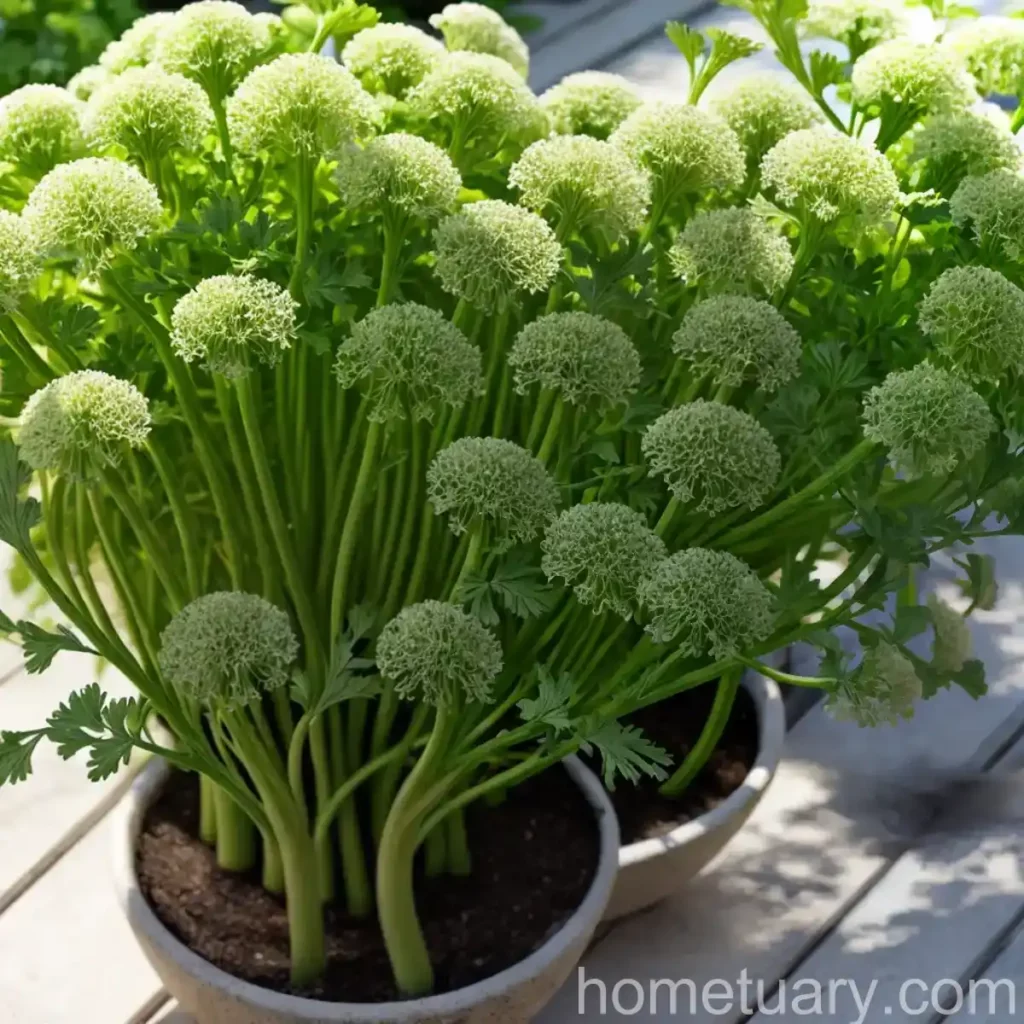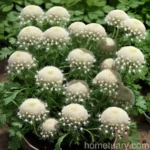The Wonderful World of Celery (Apium graveolens var. dulce)
As a plant scientist, I am delighted to take you on a journey through the fascinating world of celery. Celery (Apium graveolens var. dulce) is a versatile and nutritious vegetable with a rich history and a myriad of uses. In this comprehensive guide, we will delve into the culture, uses, care tips, diseases, and many more aspects of this beloved plant. So, grab a cup of tea, sit back, and let’s explore the wonders of celery together.
What is Celery?
Celery, scientifically known as Apium graveolens var. dulce, is a member of the Apiaceae family, which also includes carrots, parsley, and parsnips. It is a cool-season biennial plant that is primarily grown as an annual for its edible leafstalks, leaves, and seeds. The plant is cultivated for its crunchy stalks, which are a popular ingredient in salads, soups, and various dishes, as well as for its medicinal properties.
Key Takeaways
Before we delve deeper into the world of celery, let’s take a quick look at the key takeaways:
- Celery (Apium graveolens var. dulce) is a cool-season biennial plant grown for its edible leafstalks, leaves, and seeds.
- It is a versatile vegetable with culinary, nutritional, and medicinal uses.
- Celery requires well-drained soil, ample sunlight, and regular watering for optimal growth.
- Common diseases that affect celery include Early Blight, Septoria Leaf Spot, and Fusarium Yellows, among others.
- Pests such as aphids, celery leaf-tier, and snails can pose challenges to celery cultivation.
- Celery is a rich source of vitamins, minerals, and antioxidants, making it a valuable addition to a healthy diet.
Now, let’s explore each aspect of celery in detail.
Culture
Uses
The uses of celery are diverse, ranging from culinary applications to medicinal purposes. Some of the common uses of celery include:
-
Culinary Uses: Celery is a versatile ingredient in the kitchen. It is commonly used in soups, stews, salads, and stir-fries to add a distinctive crunch and flavor. Additionally, it is often enjoyed raw with dips or as a garnish.
-
Nutritional Uses: Celery is a nutritional powerhouse, rich in vitamins, minerals, and dietary fiber. It is a popular choice for juicing and is often included in detox and weight loss diets.
-
Medicinal Uses: In traditional medicine, celery has been used for its diuretic, anti-inflammatory, and antioxidant properties. It is believed to promote overall health and well-being.
Water
Proper watering is essential for the healthy growth of celery. Here are some watering tips for growing celery:
-
Consistent Moisture: Celery plants prefer consistently moist soil. Ensure that the soil remains evenly moist throughout the growing season, especially during dry periods.
-
Deep Watering: When watering, ensure that the soil is thoroughly moistened. Shallow watering can result in shallow root development, making the plants more susceptible to stress.
-
Avoid Waterlogging: While celery requires consistent moisture, it is important to avoid waterlogging the soil, as excessive moisture can lead to root rot and other issues.
Sunlight
Celery thrives in full sunlight, although it can tolerate partial shade, especially in warmer climates. Here are some sunlight requirements for growing celery:
-
Full Sun: Ideally, celery should receive at least 6-8 hours of direct sunlight per day. Adequate sunlight promotes healthy leaf and stalk growth.
-
Partial Shade: In regions with hot summers, providing partial shade during the hottest part of the day can help prevent the plants from becoming stressed and bolting prematurely.
Fertilizer
Proper fertilization is crucial for the robust growth of celery. Consider the following fertilizer tips for celery cultivation:
-
Nutrient-Rich Soil: Start with a well-balanced soil that is rich in organic matter. This provides a good foundation for the plants’ nutritional needs.
-
Nitrogen: Celery benefits from a nitrogen-rich fertilizer to support leaf and stalk development. Consider incorporating a balanced fertilizer or organic amendments to provide a steady supply of nutrients.
-
Top-Dressing: As the plants grow, consider top-dressing the soil with compost or a balanced fertilizer to sustain steady growth and development.
Soil
Celery thrives in well-drained soil with a rich organic content. Here’s a brief overview of the ideal soil requirements for growing celery:
-
Well-Drained: Ensure that the soil has good drainage to prevent waterlogging, which can lead to root rot and other issues.
-
Rich in Organic Matter: Incorporate compost or well-rotted manure into the soil to enhance its fertility and water retention capabilities.
-
pH Level: Celery prefers slightly acidic to neutral soil with a pH range of 6.0-6.8. Conduct a soil test to determine the pH level and make necessary amendments.
Pruning
Pruning celery plants can help promote air circulation, reduce disease risk, and encourage the development of healthy stalks. Here are some pruning techniques for celery:
-
Trimming Leaves: Regularly trim outer leaves as the plant grows to encourage the development of larger and more robust inner stalks.
-
Removal of Diseased Leaves: Promptly remove any yellowing or diseased leaves to prevent the spread of diseases within the plant.
-
Thin Out Plants: If celery plants are overcrowded, thin them out to provide adequate space for healthy growth and to prevent competition for resources.
Propagation
Celery is primarily propagated by seed. Here are some key tips for successfully propagating celery:
-
Seed Starting: Start celery seeds indoors 10-12 weeks before the last frost date. Ensure that the seeds are sown at the correct depth and provide adequate warmth and light for germination.
-
Transplanting: Once the seedlings have developed a few true leaves, they can be transplanted into the garden. Choose a cloudy day or late afternoon to minimize transplant shock.
-
Direct Sowing: In regions with mild winters, celery can also be directly sown into the garden in early spring or late summer for a fall harvest.
Container Popularity
Celery is well-suited for container gardening, making it an ideal choice for urban and space-limited gardeners. The following are some reasons for its popularity in containers:
-
Space Efficiency: Celery can be successfully grown in deep containers, allowing individuals with limited garden space to enjoy homegrown celery.
-
Portability: Containers offer the advantage of portability, allowing growers to move the plants to optimal sunlight and sheltered locations as needed.
-
Accessibility: Container-grown celery is easily accessible for harvesting, making it a convenient choice for home gardeners.
Container Common Diseases
When growing celery in containers, certain diseases may pose a threat to the plants. Common container diseases include:
-
Damping-Off: This fungal disease can affect young seedlings and is characterized by the sudden wilting and collapse of the plant. Proper watering practices and good air circulation can help prevent this disease.
-
Blight: Various blight diseases, such as Early Blight and Late Blight, can affect container-grown celery. Ensure proper spacing, adequate airflow, and avoid overhead watering to minimize disease risk.
-
Root Rot: Overwatering and poor drainage in containers can lead to root rot. Select well-draining containers and avoid overwatering to prevent this issue.
Disease Diagnosis
Identifying and diagnosing diseases in celery is crucial for implementing effective control measures. Here are some common celery diseases and their diagnostic features:
-
Early Blight (Alternaria Leaf Spot): Early Blight appears as circular, dark brown spots on the leaves, which may develop concentric rings. Over time, the affected tissue may dry and become papery.
-
Septoria Leaf Spot: This disease manifests as small, water-soaked spots on the leaves, which later develop into circular lesions with a dark margin and tan or gray center.
-
Fusarium Yellows: Fusarium Yellows causes yellowing and wilting of the lower leaves, eventually leading to the collapse of the entire plant. The vascular tissue may also display discoloration.
Common Pests
Pests can pose a significant threat to celery cultivation. Here are some common pests that may affect celery plants:
-
Aphids: These small, soft-bodied insects feed on the sap of plants, causing stunted growth and distortion of leaves. They can also transmit viral diseases.
-
Celery Leaf-Tier: The larval stage of this moth species feeds on celery leaves, creating webbed shelters. Severe infestations can significantly damage the foliage.
-
Snails and Slugs: These mollusks feed on young celery plants, causing irregular damage to the leaves and stems. They are particularly active in damp and cool conditions.
Botanist’s Tips
For optimal growth and successful cultivation of celery, consider the following botanist’s tips:
-
Staggered Planting: Consider staggering the planting of celery to ensure a continuous harvest throughout the growing season.
-
Companion Planting: Companion planting with aromatic herbs such as dill, parsley, and cilantro can help deter pests and attract beneficial insects to the garden.
-
Mulching: Apply a layer of organic mulch around celery plants to conserve moisture, suppress weed growth, and moderate soil temperature.
Fun Facts
Before we conclude this guide, let’s explore some intriguing and fun facts about celery:
-
The ancient Greeks used celery as a prize for winners of sports competitions.
-
Celery was considered a symbol of victory and achievement in ancient Greece.
-
The term “smallage” was used to refer to celery in medieval times.
-
The Victorian era witnessed a surge in celery cultivation, with special celery vases being used to display the vegetable on dining tables.
-
Celery seeds have been used as a traditional flavoring agent in various cuisines, particularly in pickling and seasoning.
Now that we have uncovered the rich tapestry of celery, from its cultural significance to its care tips and beyond, we hope you have gained a new appreciation for this remarkable plant.
Links to External Resources
For further exploration of celery, its cultivation, and its uses, check out the following resources:
With these valuable resources at your fingertips, you can continue to expand your knowledge of celery and enhance your gardening and culinary experiences. Happy gardening!
In conclusion, celery is a plant of remarkable versatility, offering a spectrum of culinary, nutritional, and medicinal benefits. Whether you’re harvesting its crunchy stalks for a refreshing snack, incorporating it into gourmet recipes, or exploring its therapeutic properties, celery continues to captivate and inspire.
We hope this comprehensive guide has shed light on the many facets of celery, equipping you with the knowledge and insight to cultivate and savor this exceptional plant. As you embark on your journey with celery, may each crisp bite and each verdant stalk deepen your appreciation for the remarkable world of plants.
So, go ahead, savor that crunch, relish the vibrancy of fresh celery, and marvel at the wonders of the plant kingdom. Happy gardening and happy cooking!
With that, we conclude our delightful and enlightening exploration of celery, and we hope you found this guide insightful and inspiring. Stay tuned for more captivating botanical adventures right here!
Keep discovering, keep growing, and keep flourishing with the incredible world of plants!















